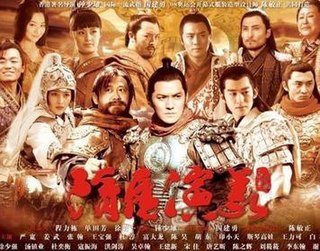Chinese classic texts or canonical texts refers to the Chinese texts which originated before the imperial unification by the Qin dynasty in 221 BC, particularly the "Four Books and Five Classics" of the Neo-Confucian tradition, themselves a customary abridgment of the "Thirteen Classics". All of these pre-Qin texts were written in classical Chinese. All three canons are collectively known as the classics.
There are traditionally four major historical capitals of China, collectively referred to as the "Four Great Ancient Capitals of China". The four are Beijing, Nanjing, Luoyang and Xi'an (Chang'an).

Luoyang is a city located in the confluence area of Luo River and Yellow River in the west of Henan province. Governed as a prefecture-level city, it borders the provincial capital of Zhengzhou to the east, Pingdingshan to the southeast, Nanyang to the south, Sanmenxia to the west, Jiyuan to the north, and Jiaozuo to the northeast. As of the final 2010 census, Luoyang had a population of 6,549,941 inhabitants with 1,857,003 people living in the built-up area made of the city's five urban districts, all of which except the Jili District are not urbanized yet.

The nobility of China was an important feature of the traditional social structure of Imperial China.
King Ping of Zhou, personal name Ji Yijiu, was the thirteenth king of the Chinese Zhou dynasty and the first of the Eastern Zhou dynasty. He was the son of King You of Zhou and Queen Shen.
King Ling of Zhou, personal name Ji Xiexin, was the twenty-third king of the Chinese Zhou Dynasty and the eleventh of Eastern Zhou. He died in 545 BC.
Sima is a Chinese family name. It is one of the rare two-character Chinese family names; most Chinese family names consist of only a single character. It is an occupational surname, literally meaning "control" (sī) "horses" (mǎ); in a similar way as the English surname Marshall is derived from the Frankish: "mare" (horse) + "skalkoz" (master). The family name originated from one of the offices of the Three Excellencies of the Zhou dynasty. The name has also been anglicised as "Szema".

From the inauguration of dynastic rule by Yu the Great in circa 2070 BC to the abdication of the Xuantong Emperor on 12 February 1912 in the wake of the Xinhai Revolution, China was ruled by a series of successive dynasties. Dividing the history of China into periods ruled by dynasties is a common method of periodization utilized by scholars.

Zhou Fang, courtesy name Zhonglang (仲朗), was a Chinese painter during the Tang dynasty. Zhou lived in the Tang capital of Chang'an, which is now modern Xi'an, during the 8th century. He came from a noble background and this was reflected in his works, such as Court Ladies Adorning Their Hair with Flowers (attributed) and Court Lady With Servants. He was influenced by the pure and detailed style of Gu Kaizhi and Lu Tanwei from the Six dynasties in his work. The late Tang art critic Zhu Jingxuan said: "Zhou Fang's Buddha, celestial beings, figures, and paintings of beautiful women are all incredible masterpieces."

Jī (姬) was the ancestral name of the Zhou dynasty which ruled China between the 11th and 3rd centuries BC. Thirty-nine members of the family ruled China during this period while many others ruled as local lords, lords who eventually gained great autonomy during the Spring and Autumn and Warring States periods. Ji is a relatively uncommon surname in modern China, largely because its bearers often adopted the names of their states and fiefs as new surnames.
The Historical Records of the Five Dynasties is a Chinese history book on the Five Dynasties period (907–960), written by the Song dynasty official Ouyang Xiu in private. It was drafted during Ouyang's exile from 1036 to 1039 but not published until 1073, a year after his death. An abridged English translation by Richard L. Davis was published in 2004.
Fàn is a Chinese family name. Is it also one of the most common surnames in Vietnam, where it is written Pham. It is the 46th name on the Hundred Family Surnames poem.

The conquest of Wu by Jin was a military campaign launched by the Jin dynasty (265–420) against the state of Eastern Wu in 280 at the end of the Three Kingdoms period (220–280) of China. The campaign concluded with the fall of Wu and the reunification of China under the Jin dynasty.
The following is a family tree of Chinese emperors (420–1279), from the Northern and Southern dynasties period, of first half of the fifth century AD, until the conquest of China by the Mongols under Kublai Khan, and the end of the Southern Song dynasty in 1279.
Duke Wu of Jin, ancestral name Ji (姬), given name Cheng (稱) and also known as Duke Wu of Quwo, was the eighteenth ruler of the state of Jin. He was also the last ruler of the state of Quwo before he gained the title as the duke of Jin.
The Zhou family of Runan was a notable Chinese family which descended from Ji Lie (姬烈), the youngest son of King Ping of the Zhou dynasty in 8th century BCE China. Ji Lie's fief was at Runan County, which became the ancestral home of his descendants. Zhou Yong (周邕), an 18th-generation descendant of Ji Lie, is considered the founding father of the Zhou family of Runan. During the Eastern Jin dynasty, the Zhou family of Runan had their home located in the north of the Huai River region. The Zhou family of Runan continued to maintain its influence after the Tang dynasty.
The Yi Zhou Shu is a compendium of Chinese historical documents about the Western Zhou period. Its textual history began with a text/compendium known as the Zhou Shu, which was possibly not differentiated from the corpus of the same name in the extant Book of Documents. Western Han dynasty editors listed 70 chapters of YZS, of which 59 are extant as texts, and the rest only as chapter titles. Such condition is described for the first time by Wang Shihan 王士漢 in 1669. Circulation ways of the individual chapters before that point are subject to scholarly debates.

Heroes in Sui and Tang Dynasties is a Chinese television series based on Chu Renhuo's historical novel Sui Tang Yanyi, which romanticises the historical events leading to the fall of the Sui dynasty and the rise of the Tang dynasty. The series was first broadcast in mainland China on various television networks on 14 January 2013. It is not to be confused with Heroes of Sui and Tang Dynasties 1 & 2, a similar television series also based on the novel, but was released earlier in December 2012. Filming for the series started on 5 November 2011 at the Hengdian World Studios and wrapped up in May 2012.
Yingchuan Commandery was a Chinese commandery from the Warring States period to Tang dynasty, located in modern central Henan province. The name referred to the Ying River, which flowed through its territory.






